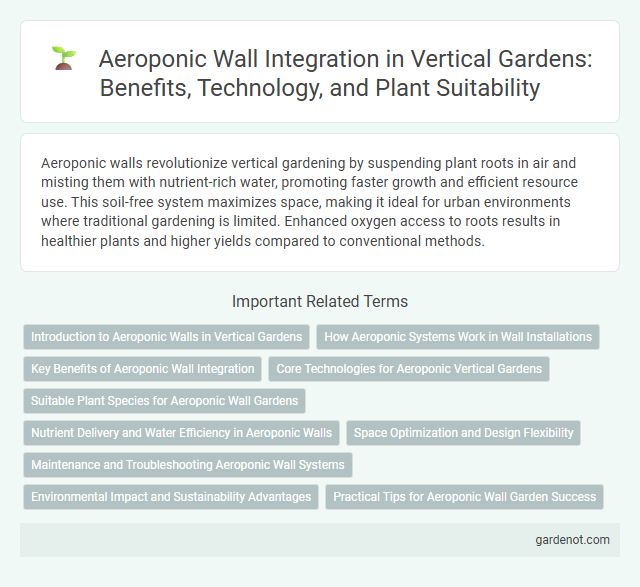Aeroponic walls revolutionize vertical gardening by suspending plant roots in air and misting them with nutrient-rich water, promoting faster growth and efficient resource use. This soil-free system maximizes space, making it ideal for urban environments where traditional gardening is limited. Enhanced oxygen access to roots results in healthier plants and higher yields compared to conventional methods.
Introduction to Aeroponic Walls in Vertical Gardens
Aeroponic walls in vertical gardens utilize mist or nutrient-rich aerosol to deliver water and nutrients directly to plant roots suspended in air, promoting faster growth and higher yields compared to traditional soil gardening. This soil-free cultivation method maximizes space efficiency and reduces water usage by up to 90%, making it ideal for urban environments and indoor farming. Innovations in aeroponic technology enable precise control over root zone conditions, enhancing plant health and sustainability in vertical farming systems.
How Aeroponic Systems Work in Wall Installations
Aeroponic systems in vertical garden wall installations utilize a misting technique to deliver nutrient-rich water directly to plant roots suspended in air, promoting faster growth and higher oxygen exposure compared to soil-based methods. These systems employ a closed environment where roots dangle freely within a mist chamber, allowing precise control over hydration and nutrient delivery through timed sprays. The efficient use of water and minimal space make aeroponic walls ideal for urban settings, maximizing plant yield while conserving resources.
Key Benefits of Aeroponic Wall Integration
Aeroponic walls maximize plant growth by delivering nutrients directly to the roots through a mist, enhancing oxygen availability and nutrient absorption for faster development. This integration conserves water by up to 90% compared to traditional soil gardening, reducing resource consumption and improving sustainability. Space efficiency is optimized as vertical structures support dense plant arrangements, ideal for urban environments and limited spaces.
Core Technologies for Aeroponic Vertical Gardens
Aeroponic walls utilize advanced misting systems that deliver nutrient-rich solutions directly to plant roots suspended in air, enhancing oxygen absorption and accelerating plant growth. Key technologies include high-pressure atomization nozzles, automated nutrient delivery controls, and integrated sensors for real-time monitoring of humidity, temperature, and pH levels. These innovations maximize water efficiency and enable precise cultivation environments essential for optimized aeroponic vertical garden performance.
Suitable Plant Species for Aeroponic Wall Gardens
Aeroponic wall gardens thrive with plant species such as leafy greens, herbs, and strawberries due to their lightweight nature and shallow roots. Basil, lettuce, spinach, and mint exhibit rapid growth and high nutrient uptake efficiency in aeroponic systems. These plants maximize space and yield, making them ideal for vertical aeroponic cultivation.
Nutrient Delivery and Water Efficiency in Aeroponic Walls
Aeroponic walls optimize nutrient delivery by suspending plant roots in an oxygen-rich mist infused with precise nutrient solutions, enhancing absorption rates and promoting faster growth compared to traditional soil methods. This system drastically reduces water usage, recycling up to 90% of water through closed-loop irrigation, minimizing waste and environmental impact. Efficient aeroponic walls maintain consistent moisture levels, ensuring uniform nutrient distribution and supporting sustainable vertical gardening in urban environments.
Space Optimization and Design Flexibility
Aeroponic walls maximize space optimization by utilizing vertical surfaces for plant cultivation, reducing the footprint required for traditional gardening. This system allows for high-density planting and modular design flexibility, enabling customization to fit various architectural styles and limited urban spaces. The aeroponic method also promotes efficient nutrient delivery and faster plant growth, enhancing productivity within compact environments.
Maintenance and Troubleshooting Aeroponic Wall Systems
Aeroponic wall systems require regular monitoring of mist nozzles to prevent clogging and ensure consistent nutrient delivery to plant roots. Maintaining optimal humidity levels and checking pump function prevents system failure and root desiccation. Troubleshooting common issues such as uneven plant growth or system leaks involves inspecting tubing, cleaning filters, and adjusting nutrient concentrations to restore balance.
Environmental Impact and Sustainability Advantages
Aeroponic walls significantly reduce water consumption by up to 90% compared to traditional soil gardening, promoting sustainable water use in urban agriculture. Their soil-free system minimizes the need for harmful pesticides and herbicides, contributing to cleaner air and reduced chemical runoff. By maximizing vertical space, aeroponic walls support biodiversity and enhance green infrastructure, which helps mitigate urban heat island effects and improves overall environmental health.
Practical Tips for Aeroponic Wall Garden Success
Maximize aeroponic wall garden success by maintaining consistent misting intervals to ensure optimal nutrient absorption and root hydration. Use water-soluble, balanced nutrient solutions with precise pH levels between 5.5 and 6.5 to promote healthy plant growth and prevent nutrient deficiencies. Regularly inspect the mist nozzles for clogs and clean them to maintain efficient nutrient delivery and prevent system failures.
Aeroponic wall Infographic

 gardenot.com
gardenot.com